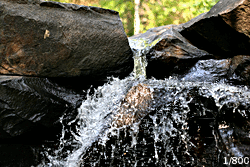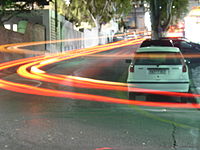Shutter speed: Difference between revisions
Justinwyne (talk | contribs) Added Shutter Priority (Tv) Description |
aperature --> aperture |
||
| Line 34: | Line 34: | ||
The ability of the photographer to take images without noticeable blurring by camera movement is an important parameter in the choice of slowest possible shutter speed for a handheld camera. The rough guide used by most [[135 film|35 mm]] photographers is that the slowest shutter speed that can be used easily without much blur due to camera shake is the shutter speed numerically closest to the lens focal length. For example, for handheld use of a 35 mm camera with a 50 mm [[normal lens]], the closest shutter speed is 1/60 s. This rule can be augmented with knowledge of the intended application for the photograph, an image intended for significant enlargement and closeup viewing would require faster shutter speeds to avoid obvious blur. Through practice and special techniques such as bracing the camera, arms, or body to minimize camera movement longer shutter speeds can be used without blur. If a shutter speed is too slow for hand holding, a camera support — usually a [[tripod]] — must be used. There are also [[Canon EF lens mount#Image stabilizer|stabilized lenses]] available. |
The ability of the photographer to take images without noticeable blurring by camera movement is an important parameter in the choice of slowest possible shutter speed for a handheld camera. The rough guide used by most [[135 film|35 mm]] photographers is that the slowest shutter speed that can be used easily without much blur due to camera shake is the shutter speed numerically closest to the lens focal length. For example, for handheld use of a 35 mm camera with a 50 mm [[normal lens]], the closest shutter speed is 1/60 s. This rule can be augmented with knowledge of the intended application for the photograph, an image intended for significant enlargement and closeup viewing would require faster shutter speeds to avoid obvious blur. Through practice and special techniques such as bracing the camera, arms, or body to minimize camera movement longer shutter speeds can be used without blur. If a shutter speed is too slow for hand holding, a camera support — usually a [[tripod]] — must be used. There are also [[Canon EF lens mount#Image stabilizer|stabilized lenses]] available. |
||
Shutter priority refers to a shooting mode used in semi-automatic cameras. It allows the photographer to choose a shutter speed setting and allow the camera to decide the correct |
Shutter priority refers to a shooting mode used in semi-automatic cameras. It allows the photographer to choose a shutter speed setting and allow the camera to decide the correct aperture. This is sometimes referred to as Shutter Speed Priority Auto Exposure, or Tv mode. |
||
==Cinematographic shutter formula== |
==Cinematographic shutter formula== |
||
Revision as of 12:54, 16 August 2007





In photography, shutter speed is the time for which the shutter is held open during the taking of a photograph to allow light to reach the film or image sensor (in a digital camera).
In combination with variation of the lens aperture, the shutter speed regulates how much light the camera will record. For a given exposure, a fast shutter speed demands a larger aperture or more light to avoid under-exposure, just as a slow shutter speed is offset by a very small aperture to avoid over-exposure. Long shutter speeds are often used in low light conditions, such as at night.
Shutter speed is measured in seconds. A typical shutter speed for photographs taken in sunlight is 1/125th of a second. In addition to its effect on exposure, shutter speed changes the way movement appears in the picture. Very short shutter speeds are used to freeze fast-moving subjects, for example at sporting events. Very long shutter speeds are used to intentionally blur a moving subject for artistic effect.[1]
In early days of photography, available shutter speeds were somewhat ad hoc.[2] Following the adoption of a standardized way of representing aperture so that each major step exactly doubled or halved the amount of light entering the camera (f/2.8, f/4, f/5.6, f/8, f/11, f/16, etc.), a standardized 2:1 scale was adopted for shutter speed so that opening one aperture stop and reducing the shutter speed by one step resulted in the identical exposure. The agreed standard for shutter speeds is:[3]
- 1/8000 s
- 1/4000 s
- 1/2000 s
- 1/1000 s
- 1/500 s
- 1/250 s
- 1/125 s
- 1/60 s
- 1/30 s
- 1/15 s
- 1/8 s
- 1/4 s
- 1/2 s
- 1 s
- B (for bulb) — keep the shutter open as long as the release lever is engaged.
- T — keep the shutter open until the lever is pressed again.
This scale can be extended at either end in specialist cameras. Some older cameras use the 2:1 ratio at slightly different values, such as 1/100 s and 1/50 s, although mechanical shutter mechanisms were rarely precise enough for the difference to have any significance.
The term "speed" is used in reference to short exposure times as fast, and long exposure times as slow. Shutter speeds are often designated by the reciprocal time, for example 60 for 1/60 s.
The ability of the photographer to take images without noticeable blurring by camera movement is an important parameter in the choice of slowest possible shutter speed for a handheld camera. The rough guide used by most 35 mm photographers is that the slowest shutter speed that can be used easily without much blur due to camera shake is the shutter speed numerically closest to the lens focal length. For example, for handheld use of a 35 mm camera with a 50 mm normal lens, the closest shutter speed is 1/60 s. This rule can be augmented with knowledge of the intended application for the photograph, an image intended for significant enlargement and closeup viewing would require faster shutter speeds to avoid obvious blur. Through practice and special techniques such as bracing the camera, arms, or body to minimize camera movement longer shutter speeds can be used without blur. If a shutter speed is too slow for hand holding, a camera support — usually a tripod — must be used. There are also stabilized lenses available.
Shutter priority refers to a shooting mode used in semi-automatic cameras. It allows the photographer to choose a shutter speed setting and allow the camera to decide the correct aperture. This is sometimes referred to as Shutter Speed Priority Auto Exposure, or Tv mode.
Cinematographic shutter formula
In cinematography, shutter speed is a function of the frame rate and shutter angle. Most motion picture film cameras use a rotating shutter with a shutter angle of 165° or 180°, which leaves the film exposed for about 1/48 or 1/50 second at a standard 24 frame/s.[4]
Where E = Exposure, F = Frames per second, and S = Shutter angle:[4]
References
- ^ Lee Frost (2000). The Complete Guide to Night and Low-Light Photography. Amphoto Books. ISBN 0817450416.
- ^ Ralph Eric Jacobson; et al. (2000). Manual of Photography: A Textbook of Photographic and Digital Imaging (Ninth ed. ed.). Focal Press. ISBN 0240515749.
{{cite book}}:|edition=has extra text (help); Explicit use of et al. in:|author=(help) - ^ Kahn, Cub (1999). Essential Skills for Nature Photography. Amherst Media. ISBN 1584280093.
- ^ a b Blain Brown (2002). Cinematography: Theory and Practice : Imagemaking for Cinematographers, Directors & Videographers. Focal Press. ISBN 0240805003.


